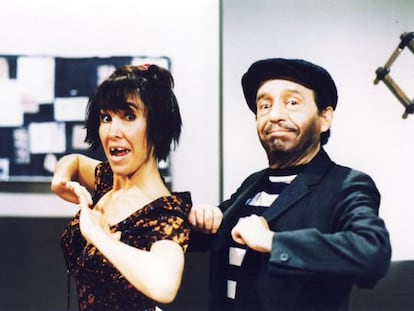Why Mexico’s weather girls have taken the country by storm
The sexism on display in the daily forecasts has stoked controversy

Carefully, they apply more powder over powder until the last pore is covered. At five in the morning, there is no place for bags under the eyes, or ordinary-looking appearances.
Finally, their porcelain faces are ready to go on air. The bodies of these female weather presenters are more important to viewers than the forecast itself. In fact, some people are even known to lower the volume so they can concentrate better on the screen.
They are Mexico’s weather girls, the most profitable thing on the country’s networks today.
“All of the women are beautiful and don’t need a lot of makeup to prove this,” says Yanet García, one of the forecasters.
So why don’t they just appear on-air naturally?
“Because we have a big responsibility. We are women whom others aspire to be,” she explains.
The 25-year-old Yanet García has become a sensation in Mexico and the US for her presenting style
The 25-year-old García has become a sensation in Mexico and the United States for her presenting style. Her athletic body recklessly defies gravity – the other presenters of Televisa Monterrey, where she works, jokingly warn viewers that she might be from another planet as she shows off her curves.
In just a few months, García has become the channel’s biggest star. It doesn’t bother her that some have accused her of just being a sex object – a common criticism among those interviewed for this story, who consider that this form of entertainment is simply a way of encouraging more sexism in Mexico.
“I ignore the bad reviews,” she says.
“Sure, girls aspire to be like her,” says Ana Francis, a member of feminist movement Las Reinas Chulas (The cool queens). “They tell you this all your life, it doesn’t matter if you study and train for a profession. In the end, the only real evaluation for a woman is whether or not she is beautiful.
“And just when you think you have the best job in your profession, there is always that moment when they make you see you are no longer queen of the world. They remind you that, at most, you are the foreman of the company. They are the owners,” explains Francis.
Behind every weather girl is a man who has given them his support.
“I am not like the others who come here to model. I am part of a serious newscast where the people judge you by your credibility”
“I give thanks to God for all the blessings, especially Mauro Morales, who pushed me and shows me every day how I should do things,” says García about her boss.
Morales is in charge of the weather department at Televisa Monterrey, and is the one who shows the girls how they should act on set.
They are to “be pleasant in front of the cameras” and also need to maintain a healthy diet.
“You have to remember that that this is a commercial station,” says Morales. “We owe it to our viewers and also to our sponsors. Obviously, if a sponsor has a beautiful woman the product is going to have a greater impact. And this is of great benefit for everyone.”
The set on to which the girls march out looks more like a photo call on a Hollywood red carpet: they show up wearing miniskirts and high heels, or in dresses with low-necklines, or that tightly hug their bodies.
“They say that we have to be beautiful and thin, but not too skinny,” explains Arlett Fernández, 35, who has been presenting the weather at the Multimedios y Milenio Televisión group for the past 11 years. “But they don’t tell us how to dress.”
“I am not like the others who come here to model; if I wanted to do that, I would go on the catwalk. I am part of a serious newscast where the people judge you by your credibility,” she says.
The girls purposely show their backs to the camera and sometimes bend down to point out a temperature
But in some weather forecasts, the girls purposely show their backs to the camera and sometimes bend down a bit to point out a temperature on a map. These are movements that have been rehearsed and practiced to the last detail.
“It is important to have a good body,” says Gabriela Lozoya, 30, who works with Yante García at Televisa Monterrey. “I put myself in the shoes of the viewer and if I see someone ugly on screen, I change the channel.”
The weather girl phenomena began in 2000 when private networks were allowed to start broadcasting and competition grew fierce. Since then, the weather girls have ousted the traditional jacket-and-tie forecasters in a battle for ratings. These days, the men only appear when serious weather conditions are heading in.
At one time Milenio Televisón tried having a young guy present the weather, “but the owners didn’t think it was a good idea,” recalls Abimael Salas, chief meteorologist at Milenio.
Marta Lamas, an influential figure in the Mexico’s feminist movement, says that “sexism in Mexico has been part of the country’s national identity” since the Mexican Revolution.
“Television is merely a reflection of the reality of our country,” she says.
English version by Martin Delfín.
Tu suscripción se está usando en otro dispositivo
¿Quieres añadir otro usuario a tu suscripción?
Si continúas leyendo en este dispositivo, no se podrá leer en el otro.
FlechaTu suscripción se está usando en otro dispositivo y solo puedes acceder a EL PAÍS desde un dispositivo a la vez.
Si quieres compartir tu cuenta, cambia tu suscripción a la modalidad Premium, así podrás añadir otro usuario. Cada uno accederá con su propia cuenta de email, lo que os permitirá personalizar vuestra experiencia en EL PAÍS.
¿Tienes una suscripción de empresa? Accede aquí para contratar más cuentas.
En el caso de no saber quién está usando tu cuenta, te recomendamos cambiar tu contraseña aquí.
Si decides continuar compartiendo tu cuenta, este mensaje se mostrará en tu dispositivo y en el de la otra persona que está usando tu cuenta de forma indefinida, afectando a tu experiencia de lectura. Puedes consultar aquí los términos y condiciones de la suscripción digital.
More information
Últimas noticias
Most viewed
- Cartels in Mexico take a leap forward with narco-drones: ‘It is criminal groups that are leading the innovation race’
- Christian Louboutin: ‘Young people don’t want to be like their parents. And if their parents wear sneakers, they’re going to look for something else’
- A mountaineer, accused of manslaughter for the death of his partner during a climb: He silenced his phone and refused a helicopter rescue
- If AI replaces workers, should it also pay taxes?
- Belle da Costa, the woman who concealed her origins in 1905 and ended up running New York’s most legendary library











































